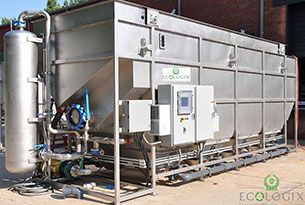Introduction
Wastewater treatment is critical for industries to meet regulatory standards and maintain operational efficiency. Two common technologies, Dissolved Air Flotation (DAF) systems and clarifiers, are designed to remove contaminants like suspended solids, fats, oils, and greases from wastewater. However, their applications differ based on wastewater composition, treatment goals, and operational constraints. This article explores when to choose a DAF system versus a clarifier, providing practical insights for industrial facilities. For expert guidance, visit https://ecologixsystems.com.

Part A: Understanding DAF Systems
DAF systems use air bubbles to float light particles, oils, and greases to the surface of a treatment tank, where they are skimmed off [1].
Key Processes:
- Air Injection: Pressurized air dissolves into the wastewater, forming microbubbles upon release.
- Flotation: Bubbles attach to particles, reducing their density and causing them to rise.
- Skimming: Floating solids are removed, leaving clarified water.
Applications and Benefits:
- Ideal for wastewater with high oil and grease content (e.g., food processing, petrochemical industries).
- High removal efficiency for oils, greases, and fine solids.
- Faster treatment compared to sedimentation-based systems.
- Suitable for facilities with limited space due to compact design.
Limitations:
- Higher operational costs due to energy use and moving parts.
- Requires maintenance on motors and pumps.
Part B: Understanding Clarifiers
Clarifiers rely on gravity sedimentation to settle heavier solids to the bottom of a tank, where they are removed as sludge [2].
Key Processes:
- Sedimentation: Heavy particles sink due to gravity.
- Sludge Removal: Settled solids are collected via scrapers or pumps.
- Clarified Water Extraction: Clean water is decanted from the top.
Applications and Benefits:
- Best for wastewater with high concentrations of settleable solids (e.g., mining, municipal wastewater).
- Lower operational costs compared to DAF systems.
- Simple design with minimal energy requirements.
- Effective for high-density solids.
- Suitable for large-scale operations with consistent wastewater characteristics.
Limitations:
- Slower treatment process, requiring larger tank volumes.
- Less effective for oils, greases, or low-density solids.
Part C: Key Comparison Factors
The choice between a DAF system and a clarifier depends on several factors. This table summarizes key considerations:
| Factor | DAF System | Clarifier |
|---|---|---|
| Primary Contaminants | Oils, greases, fine solids | Heavy, settleable solids |
| Treatment Speed | Fast (minutes) | Slow (hours) |
| Space Requirements | Compact | Large footprint |
| Energy Use | Moderate (air compressor, pumps) | Low (gravity-based) |
| Maintenance Complexity | Moderate to high | Low to moderate |
| Cost | Higher upfront and operational costs | Lower operational costs |
Case Study Example
A food processing plant with high oil content in its wastewater implemented a DAF system, achieving 95% removal of oils and greases, compared to a clarifier's 70% efficiency for the same stream [3]. Conversely, a mining facility with heavy sediment loads opted for a clarifier, reducing solids by 90% at lower costs.
Challenges and Recommendations
Challenges in Choosing the Right System:
- Wastewater Variability: Inconsistent wastewater composition can reduce system efficiency.
- Space Constraints: Limited facility space may rule out clarifiers.
- Budget Limitations: High upfront costs of DAF systems can be prohibitive.
- Regulatory Compliance: Stricter discharge standards may favor one system over the other.
Actionable Solutions:
- Analyze Wastewater Composition: Conduct a wastewater analysis to determine contaminant types and concentrations. DAF systems excel for oils and fine solids, while clarifiers are better for heavy solids.
- Evaluate Space and Budget: Choose DAF for compact facilities; opt for clarifiers in cost-sensitive or large-scale operations.
- Consult Experts: Contact Ecologix Environmental Systems at https://ecologixsystems.com/contact for customized system design and integration.
- Hybrid Systems: Consider integrated solutions combining DAF and clarifiers for complex wastewater streams.
Glossary
- DAF (Dissolved Air Flotation):
- A treatment process using air bubbles to float contaminants for removal.
- Clarifier:
- A sedimentation-based system that removes settleable solids via gravity.
- Suspended Solids:
- Particles suspended in wastewater, including oils, greases, and sediments.
- Sludge:
- Settled solids removed during wastewater treatment.
Frequently Asked Questions (FAQ)
Q: Can DAF systems and clarifiers be used together?
A: Yes, hybrid systems can address complex wastewater streams, combining DAF's oil removal with clarifiers' sedimentation capabilities.
Q: Which system is more cost-effective?
A: Clarifiers generally have lower operational costs, but DAF systems may be more cost-effective for specific contaminants like oils.
Q: How do I know which system my facility needs?
A: Conduct a wastewater analysis and consult experts like Ecologix Environmental Systems at https://ecologixsystems.com for recommendations.
Conclusion
Selecting between a DAF system and a clarifier depends on wastewater characteristics, operational constraints, and treatment goals. DAF systems are ideal for removing oils, greases, and fine solids in compact, high-efficiency setups, while clarifiers suit heavy solids and cost-conscious operations. By understanding these technologies, facilities can optimize wastewater treatment and ensure compliance. For tailored solutions, reach out to Ecologix Environmental Systems at https://ecologixsystems.com/contact.
Bibliography
- Water Environment Federation, "Industrial Wastewater Management, Treatment, and Disposal," 3rd ed., 2008.
- Metcalf & Eddy, "Wastewater Engineering: Treatment and Resource Recovery," 5th ed., 2014.
- Ecologix Environmental Systems, "Case Studies on Wastewater Treatment Solutions," https://ecologixsystems.com/case-studies, accessed October 15, 2025.

